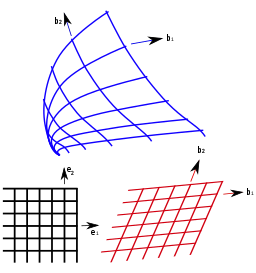

He'd agreed to do this way back when he still thought he knew what he was talking about.
Divergence in curved space series#
Einstein was due to give a series of four lectures - one a week - on general relativity in Berlin. He worked for months, sometimes forgetting to eat or sleep. He got depressed at first, but then he buckled down and started from scratch. In 1915 had to admit that his theory was rubbish. For two years he tried to fix it up, but somehow he just couldn't quite do it - nagging doubts started to creep in. He realised it wasn't perfect, but he thought it was basically right and just needed a little polishing.
Divergence in curved space cracked#
It took him eight years to get to the final answer.Įinstein first thought he'd cracked the problem in 1913 when he came up with what he called an "outline" of the theory. In 1907 Einstein started thinking more deeply about gravity, going right back to basics. Eight years of thoughtĪt first Einstein thought he could fix the problem by tinkering with Newton's equations, but this didn't work. How fast does gravity travel across the solar system? Image courtesy NASA. He'd try to find some contradiction and when there was something that didn't make sense, that's what he'd focus on. He would cook up these scenarios in his head and just push them to the limit. The Sun explodes and all he worries about is whether the Earth travels in circle or a straight line. In case it's not obvious, we should point out that Einstein was not a pragmatic man. Because, according to him, nothing can travel faster than the speed of light - not even the effects of gravity. But Einstein said that couldn't be right. Einstein's puzzle was when that would happen: straight away, or after eight minutes? According to Newton's theory, the Earth should know immediately that the Sun had disappeared. If the Sun wasn't there, it would move off in a straight line. Since the Sun is so far away that it takes light eight minutes to travel to Earth, we wouldn't know about the explosion straight away.īut what about gravity? The Earth moves around the Sun, due to the Sun's gravity. Special relativity put Einstein in conflict with a theory that was then considered the bedrock of science: Isaac Newton's theory of gravity which had been around for nearly 250 years.Įinstein wondered what would happen if the Sun were to suddenly explode. We don't notice this speed limit of the Universe in our everyday lives because the speed of light is really fast: around 700 million miles per hour. Einstein was led to this idea by asking questions such as "what would a light beam look like if you were running alongside it?". The laws of physics conspire so that nothing can ever travel faster than light. The central idea of the theory is that there is a speed limit in our Universe. One of the things he produced in 1905 was the special theory of relativity. The job left Einstein with lots of spare time to think about science. Instead, he was working as a civil servant in Switzerland, on the lowest rung of the ladder as a junior patent clerk in Bern. Einstein was quite a cocky young man at that time, and because he had annoyed pretty much every scientist he ever met, he didn't have a job at a university. Physics in the patent officeĮinstein discovered general relativity in 1915 when he was 36 years old, but the seeds were sown in 1905. General relativity is one of the greatest achievements in the history of science.Īlbert Einstein in 1904. It is the theory which explains why apples fall from trees, why we are all stuck to the Earth, why the Moon orbits the Earth, and the Earth orbits the Sun. His greatest achievement is the general theory of relativity, which describes how the force of gravity works. Albert Einstein is one of the most famous scientists in history.


 0 kommentar(er)
0 kommentar(er)
